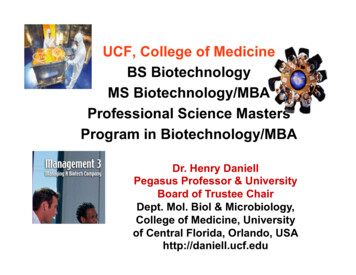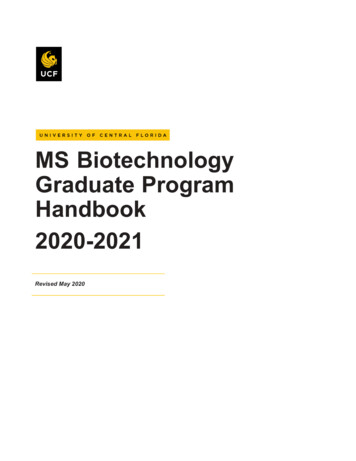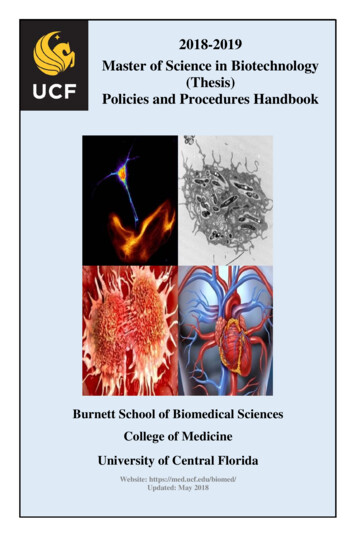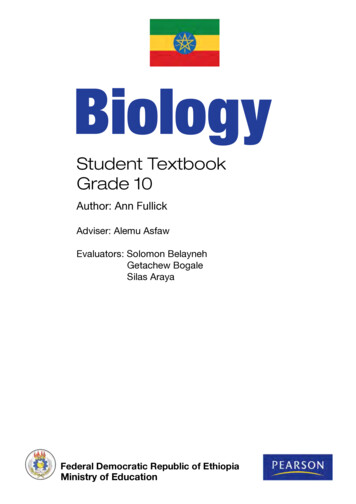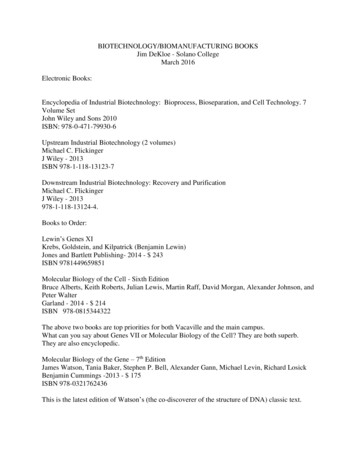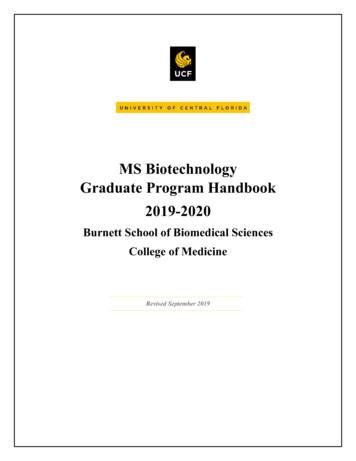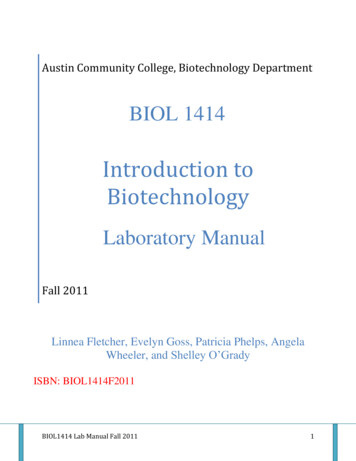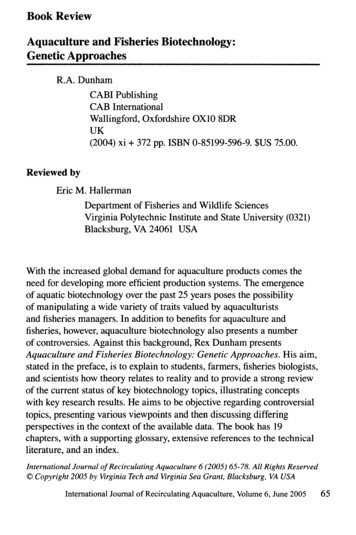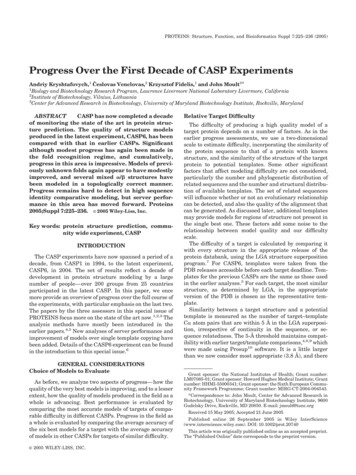
Transcription
CURRICULUMfor the Academic year 2018 – 2019DEPARTMENTBIOTECHNOLOGYI-IVOFSemesterM.Tech. BiotechnologyRAMAIAH INSTITUTE OF TECHNOLOGY(Autonomous Institute, Affiliated to VTU)BANGALORE – 54
About the Institute:Ramaiah Institute of Technology (RIT) (formerly known as M. S. Ramaiah Institute of Technology) is aself-financing institution established in Bangalore in the year 1962 by the industrialist and philanthropist,Late Dr. M S Ramaiah All engineering departments offering bachelor degree programs have been accreditedby NBA. RIT is one of the few institutes with faculty student ratio of 1:15 and achieves excellent academicresults. The institute is a participant of the Technical Education Quality Improvement Program (TEQIP), aninitiative of the Government of India. All the departments are full with competent faculty, with 100% ofthem being postgraduates or doctorates. Some of the distinguished features of RIT are: State of the artlaboratories, individual computing facility to all faculty members. All research departments are active withsponsored projects and more than 130 scholars are pursuing PhD. The Centre for Advanced Training andContinuing Education (CATCE), and Entrepreneurship Development Cell (EDC) have been set up oncampus. RIT has a strong Placement and Training department with a committed team, a fully equippedSports department, large air-conditioned library with over 80,000 books with subscription to more than 300International and National Journals. The Digital Library subscribes to several online e-journals like IEEE,JET etc. RIT is a member of DELNET, and AICTE INDEST Consortium. RIT has a modern auditorium,several hi-tech conference halls, all air-conditioned with video conferencing facilities. It has excellent hostelfacilities for boys and girls. RIT Alumni have distinguished themselves by occupying high positions in Indiaand abroad and are in touch with the institute through an active Alumni Association. RIT obtainedAcademic Autonomy for all its UG and PG programs in the year 2007. As per the National InstitutionalRanking Framework, MHRD, Government of India, Ramaiah Institute of Technology has achieved 60th rankin 2018 among the top 100 engineering colleges across India.
About the Department:The department of Biotechnology established in 2002 offers a four year B.E. Biotechnology Program withan intake of 60 students and a two years PG Program, M.Tech in Biotechnology with an intake of 18students. The department is a recognized Research Centre by VTU, Belgaum, offering M.Sc (Engg.) byresearch and PhD programs. The Department also offers a Post Graduate Diploma in BiopharmaceuticalTechnology under the Biotechnology Skill Enhancement Programme (BiSEP), supported by the Departmentof IT & BT, Government of Karnataka with a sanctioned budget of Rs. 162.5 Lakhs.The department has 16 faculty members, of them ten are Ph.D holders and the others are M.Tech pursuingPh.D. The faculty members have competence in Core areas of Biotechnology viz. Food and AgriculturalBiotechnology, Health and Medical Biotechnology & Environmental Biotechnology and BioprocessEngineering. The department research is focused towards these core areas and funded by national and statefunding agencies like DST, KBITS, AICTE, VGST, VTU and RGUHS.The department faculties and students have publications in Scopus Indexed peer reviewed Journals ofElsevier, Taylor and Francis and Springer. Faculties have published book chapters and presented theirresearch work in National and International conferences. A sizeable number of students have pursued theirhigher education at various premier institutes in India and abroad after having qualified GATE, GRE &TOEFL exams. The students undergo internships at various premier institutes in India and abroad. Severalstudents receive the Indian Science Academies Summer Internship every year.The department hascollaborations with some of the leading biotech industries like: Biocon, Hindustan Unilever Limited (HUL),Bristol Myers Squibb India Ltd, Novozymes South Asia Pvt Ltd, Himalaya Drug Company, BeckmanCoulter, Sami Labs, Sartorius AG, Genotypic Technology, Aristogene Biosciences, GangaGen, ConnexiosLife Sciences, Acquity Labs & Celest Pharma.
VISION OF THE INSTITUTE“To be an Institution of International Eminence, renowned for imparting quality technical education, cuttingedge research and innovation to meet global socio economic needs”MISSION OF THE INSTITUTEMSRIT shall meet the global socio-economic needs throughImparting quality technical education by nurturing a conducive learning environment throughcontinuous improvement and customizationEstablishing research clusters in emerging areas inorganizationscollaboration with globally reputedEstablishing innovative skills development, techno-entrepreneurial activities and consultancy for socioeconomic needsQUALITY POLICY“We at M. S. Ramaiah Institute of Technology strive to deliver comprehensive, continually enhanced, globalquality technical and management education through an established Quality Management Systemcomplemented by the synergistic interaction of the stake holders concerned”VISION OF THE DEPARTMENT“To be a leading Biotechnology Engineering department that imparts quality technical education withstrong research component, to develop solutions in the field of food, health and environment”MISSION OF THE DEPARTMENT“To provide quality technical education in a conducive learning environment to produce professionals,researchers with a zeal for lifelong learning and a commitment to society”
Programme Educational Objectives (PEOs) of the programPEO 1: To produce postgraduates who can articulate technical developments in the field of biotechnologyand apply relevant tools to solve problems in real life situationsPEO 2: To enable postgraduates to have an ability to design and conduct research to meet desired needswithin realistic economic, environmental, socio-political, ethical, health, safety & sustainability realmsPEO 3: To prepare post graduates to be successful professionals in industry, academia, research,entrepreneurial pursuit and consulting firmsPEO 4: To prepare students to enrich their knowledge & skills throughout their careerProgramme Outcomes (POs)PO1: An ability to independently carry out research/investigation & development work to solve practicalproblemPO 2: An ability to write & present a substantial technical report/documentPO 3: Students should be able to demonstrate a degree of mastery over the area as per the specialization ofthe programme. The mastery should be at a level higher than the requirements in the appropriate bachelorprogramPO 4: Demonstrate the ability to design, conduct experiments and analyze data in the field of BiotechnologyPO 5: Able to employ Biotechnology tools in biological research
SCHEME OF TEACHING FOR THE BATCH 2018-2020I SEMESTERCreditSI. No.Subject CodeSubjectLTTotalP1MBT11Cell and Molecular Biology40042MBT12Experimental Design31043MBTE XXElective 140044MBTE XXElective 240045MBTE XXElective 8MBT15Technical Seminar-I0022191424TotalL- LectureT-TutorialP-Practical
II SEMESTERCreditSI. No.Subject CodeSubjectLTTotalP1.MBT21Bioprocess Engineering31042.MBT22Biopharmaceutical Technology40043.MBTEXXElective 440044.MBTEXXElective 540045.MBTEXXElective 640046.MBT L23Practical – III00117.MBT L24Practical – IV00118.MBT25Technical Seminar-II0022191424TotalL- LectureT-TutorialP-Practical
III SEMESTERCreditSI. No.Subject CodeSubjectLTPTotal1.MBT31Bioethics & Intellectual Property Rights31042.MBTEXXElective 740043.MBT 33Internship / Industrial Training00444.MBT 34Project Work -I0066711018TotalIV SEMESTERCreditSI. No.1.Subject CodeMBTPSubjectProject Work-IITotalL- LectureT-TutorialP-PracticalLTTotal002222002222P
ELECTIVESSl NoSubject CodeCreditSubjectLTPTotal1MBTE01Industrial and Environmental Biotechnology40042MBTE02Recombinant DNA Technology40043MBTE03Advanced Upstream and Downstream Technology40043MBTE04Medical Biotechnology40044MBTE05Bioreaction Engineering40045MBTE06Toxicology and Forensic science40046MBTE07Plant Biotechnology40048MBTE08Applied Bioinformatics40049MBTE09Advanced Research Methodology400410MBTE10Applied Animal Biotechnology400411MBTE11Bioanalytical and Biophysical Techniques400412MBTE12Protein Engineering & Industrial Applications400413MBTE13Bioreactor 5Biotechnology of Alternative Fuels400416MBTE16Metabolic Engineering4004L- LectureT-TutorialP-Practical
CELL AND MOLECULAR BIOLOGYSub CodeCredit: MBT11: 4:0:0CIESEE: 50 Marks: 50 MarksCourse coordinators: Dr. Ravikumar Y SUnit-ICell Structure and Organization: Prokaryotic and Eukaryotic cell structure Membrane composition,structure, transport systems: cell-cell interaction: Cell - cell adhesion, cadherins, CAMS (NCAMS),selectins, integrins, desmosomes, hemidesmosomes, tight junction, gap junction, Catenins. Cytoskeleton:types, organization and their functions Cell organelles structure and functions Nucleus, mitochondria,chloroplast. Intracellular compartments and their characteristic features; membranes and proteins involvedin transport-structures involved in trafficking of proteins. Protein sorting- secretory pathway; receptormediated endocytosis, sorting of internalized proteins; vesiculation, transport and targeting;Unit-IICell Signaling and Cell Cycle: Cell Signaling- autocrine, paracrine, endocrine systems. Synaptic; role ofGap junction in signal sharing, Effect of concentration of signals.Structure and function of cell surfacereceptor; Intracellular receptorsand nuclear receptors; signal mediated signal transduction for different typesof signaling molecules G-protein and PI3 mediated signal transduction. RTKmediated signaltransduction,Small intracellular signalling molecule. Cell cycle: cell cycle events in animal cells; checkpoints during cell cycle-G1 to S, role of cyclins and CDKs, synthesis and degradation of cyclins, structuralfeatures of CDKs and cyclins, activation and inactivation of cyclin dependent kinases. Mitosis and meiosisand molecular events occurs during mitosis and meiosis.Unit-IIIDNA replication (prokaryotes and eukaryotes): Mode of replication, DNA polymerases, composition andfeatures, origin of replication, replication factors and the mechanism of replication, leading strand andlagging strand synthesis, procesessivity, fidelityand regulation of replication. Termination of replication.Eukaryotic-replication origins, replication initiation complexes and their assembly, licensing factors, DNApolymerases and their composition, telomerase and mode of action, replication factors, disassembly ofchromatin components and DNA damage and repair: types and their repair.Unit-IVTranscription and RNA processing: Prokaryotic Transcription: Promotor and their structure, E. coli RNApolymerase, Initiation, functions of s factors, elongation, termination. Eukaryotic transcription: types ofRNA polymerases and promoters. RNA Pol II structure and subunit functions. General transcription factors,mechanism of Initiation, elongation, termination. rRNAs; Structural features of rRNAs- prokaryotic andeukaryotic. tRNAs: structural features, their anticodon feature tRNA charging and capping. mRNAsprokaryotic and eukaryotic mRNAs, structural feature. RNA Processing: exons & introns, splicing,spliceosomes, snRNPs, self-splicing introns, Alternative splicing, transsplicing, capping, polyadenylationand RNA editing.Unit-VProtein Synthesis and gene regulation: Translation: Translation initiating factors, ribosome structure &function, elongation factors, termination factors; mechanism of chain initiation, elongation and terminationand genetic code. Protein folding: molecular chaperon, HAS 70 and Gro EL/Groes complex. Post
translational modification: Regulation of prokaryotic gene expression: Operons and their types, Regulationof Lac operon, Tryptophan operon. Role of sigma factors in gene expression regulation. Regulation ofeukaryotic gene expression: Levels of gene regulation, DNA binding proteins, Histone modification andChromosome remodeling: RNA intereference, siRNAs, miRNAs, & enhancers, protein degradation andturnoverTextbooks:1. Bruce A. et al (2007) Molecular Biology of the Cell, 5th edition, Garland science, New York,USA.2. Pierce BA. (2012), Genetics A Conceptual Approach IV edn. W. H. Freeman and Company New YorkReference Books1. Hardin J et al. (2012)Becker’s World of the Cell VIII edn. Pearson Benjamin Cummings, SanFrancisco, USA.2. Gerald Karp. (1996). Cell and Molecular Biology. John Wiley and Sons. Inc3. Lodish H et al (2016). Molecular cell Biology. W. H. Freeman and Company New York, USA4. Brown T A. G (2012) Genetics: A molecular approach, Garland Science, Taylor & Francis Group, NewYork,USA,5. Krebs JE. (2014) Lewin’s Genes XI, Jones & B artlett Learning, Burlington, USA.Course Outcomes: On completion of this course student will have improved ability1. To describe basic cellular concepts and organization and principles of cell membrane cytoskeleton anddifferent cell organelles. (PO1, PO3, PO4, PO5)2. To describe the molecular mechanisms for cell growth, cell death, and renewal of the cells andinteractions of cell with its environment. (PO1, PO3, PO4)3. To understand and apply the principles and techniques of molecular biology which will be necessary forstudy of mechanism DNA replication and repair. (PO1, PO3, PO4, PO5)4. To correlate the mechanism of prokaryotic and eukaryotic transcription process and appraise thedifferent types of RNA processing methods used by cell. (PO1, PO3)5. To understand the mechanisms of prokaryotic and eukaryotic translation and describe various levels ofgene expression regulation. (PO1, PO3)
EXPERIMENTAL DESIGNSub CodeCredits: MBTE12: 4:0:0CIESEE: 50 Marks: 50 MarksCourse coordinators: Dr. S H C V Subba BhattaUNIT-IRandom variables — discrete and continuous, Mathematical expectation and its laws, Moments, coefficientof skewness and kurtosis. Probability distributions — Bernoulli/Binomial, Poisson, Geometric, NormalJoint probability distributions for discrete and continuous random variables, conditional expectation,stochastic independence.UNIT-IICorrelation, Regression analysis, Partial and multiple correlation and regression, Regression diagnostics residuals, multicollinearity, testing adequacy of fit and validation in regression analysis; Samplingdistribution of correlation and regression coefficients; Testing of hypothesis: z – test, t-test, Chi-square testand F-test.UNIT-IIIConcept of analysis of variance (ANOVA) for one-way and multi-classified experiments; Multiple MeanComparison, Pair wise Contrasts, Type of Models (Fixed or Random), Incomplete Blocks/Missing dataFisher’s principles, Basics of designing an experiment. Completely Randomized Design (CRD), Principlesand Usage, Randomization, Data Analysis/Model (one-way ANOVA), Advantages/Disadvantages, IdealConditions. Randomized Complete Block Design (RCBD), Data Analysis, Advantages and disadvantages,Comparison with CRD.UNIT-IVLatin Square Design, Construction and arrangement, Analysis, Relative efficiency of LSD over CRD andRCBD. Graeco Latin Square Design: Construction and arrangement, data analysis. Factorial Experiments:22 and 23 Designs, the general 2k Design, Methods to find the factorial effects, Yate’s algorithm ofcomputing factorial effects.UNIT-VBlocking and confounding, Blocking a 2 factorial design, Confounding in 2k factorial design, Partial andComplete Confounding. Two level fractional factorial designs, One half fraction of the 2k design, Onequarter fraction of the 2k design, Plackett- Burman design Analysis of Covariance (ANCOVA),Assumptions and Model for ANCOVA, Statistical analysis.kTest books:1. Douglas C. Montgomery (2009) Design and Analysis of Experiments, 7th Edition, Wiley publication.2. Misra BL (2005) Design & Analysis of Experiments for Agricultural Workers, 1 st Ed, Kalyan Pub.Reference Books:1. Steel & Torrie (1980) Principals and Procedures of Statistics A Biometrical Approach, McGraw-Hill Publication.2. Kuehl (2000) Design of Experiments: Statistical Principals of Research Design and Analysis. Duxbury press.
Course Outcome: On completion of this course student will have improved ability to:1. Identify the random variables and use standard discrete and continuous probability distributions. (PO-4)2. Perform test of hypothesis for a given data using parametric and nonparametric tests. (PO-4)3. Apply one way and two way ANOVA for CRD and RCBD. (PO-4, 5)4. Apply three way and four way ANOVA for Latin Squares and Graeco Latin Squares and construct afactorial experiment. (PO-4, 5)5. Apply Blocking and construct fractional factorial design. (PO-4, 5)
PRACTICAL - ISub CodeCredit: MBTL13: 0:0:1CIESEE: 50 Marks: 50 MarksCourse coordinators: Dr. Sravanti V and Dr. Ahalya NLIST OF EXPERIMENTS1. Isolation of Lipolytic bacteria2. Production of Amylase by fermentation technique3. Demonstration of lysogeny in E. coli4. Measurement of BOD of waste water5. Determination of sugar/glucose transport in S. cerevisiae6. Production and estimation of citric acid from microbes7. Production and estimation of lactic acid from microbes8. Determination of growth curve and growth inhibition9. Cultivation of Anaerobes10. Production and estimation of Single Cell Protein11. Glucose uptake by bacteria12. Ultraviolet irradiation survival curve13. Effect of pH, osmotic pressure on growth of microbes14. Isolation of YeastNote: At least any 12 experiments must be performedText Books:1. Gerhardt, P., Murray, R.G., Wood, W.A. and Kreig, N.R. (1994) Methods of General and MolecularBacteriology, Ed. American Society for Microbiology, Washington D.C.2. P. M. Rhodes and P. F. Stanbury (1997) Applied Microbial Physiology : A Practical Approach, IRLPressReference books:1. Cappuccino J.G, Sherman N (1999) Microbiology: A Laboratory Manual, 4th Edn., Addison-WesleyInternational Student.2. Prescott, Harley and Klein (2008) Laboratory Exercises in Microbiology, 7th Ed Harley, McGraw-Hill,USA3. Pollack RA, Walter F, Mondschein W, Modesto R (2004) Laboratory Exercises in Microbiology, 2ndEdn.John Wiley Publication.Course Outcome: On completion of this course student will have improved ability:1. To design, execute, analyze experiments independently and improve scientific writing skills (PO1, PO2,PO3, PO4, PO5)2. To estimate and quantify organic acids, proteins, sugars. (PO1, PO4, PO5)3. To apply basic biochemical techniques in Environmental Biotechnology. (PO3, PO5)4. To isolate, grow microbes and express secondary metabolites for various applications. (PO1, PO3, PO5)5. To correlate the effect of environmental factors on microbial growth. (PO3, PO5)
PRACTICAL - IISub CodeCredits: MBTL14: 0:0:1CIESEE: 50 Marks: 50 MarksCourse coordinators: Dr. Prabha MLIST OF EXPERIMENTS1. Introduction to recombinant DNA technology and good laboratory practices2. Cell disruption3. Protein precipitation by NH4SO4 by solvent methods and its recovery4. Protein purification by chromatography5. Cloning: transfer a gene into plasmid vector and transformation into bacteria6. Screening of recombinant bacteria7. Establishment of plant/animal cell culture8. Transformation of plant/animal cells through vector carrying gene of interest9. Screening and characterization of transformed cells10. Estimation and Isolation of total DNA from tissues/cells11. Characterization of DNA by Southern blot12. Detection of recombinant proteins by Western blotting13. Amplification of target DNA by PCR14. Isolation and quantification of RNANote: At least any 12 experiments must be performedText books:1. Russell, David W, Sambrook, Joseph (2001). Molecular cloning: a laboratory manual. Volumes I - III.Cold Spring Harbor laboratory Press, USA.2. Channarayappa (2006) Molecular Biotechnology: Principles and Practices. Universities Press (India) Pvt.Ltd. Worldwide publishing: CRC Press, Taylor and Francis.3. Harris ELV and Angal S (1988) Protein purification methods, Ed. IRL Press at Oxford University press.Reference Books:1. Brondyk W. H. (2009) ―Chapter 11 selecting an appropriate method for expressing a recombinantprotein‖. Methods in enzymology 463: 131-147.2. Old RW and Primrose SB (1993) Principles of gene manipulation, an introduction to genetic engineering.Blackwell Scientific Publications.Course Outcome: On completion of this course student will have improved ability:1. To perform cell disruption and the protein purification process and their applications. (PO1)2. To understand the importance of cloning and gene transformation in bacteria and their applications ingenetic engineering. (PO4)3. To establish the animal cell culture and their benefits in DNA transfection and gene cloning. (PO1)4. To gain the knowledge in the production of recombinant proteins in research. (PO2)5. To know the characteristics of nucleic acids and applications of recombinant DNA proteins in themedicine, industry, agriculture and an environment. (PO5)
BIOPROCESS ENGINEERINGSub CodeCredit: MBT21: 3:1:0CIESEE: 50 Marks: 50 MarksCourse coordinators: Mrs. Bhavya SG and Dr. Chandraprabha MNUNIT-IBioprocessing Fundamentals:Biotechnology and Bio-process engineering-Historical development of bioprocess technology-Difference inapproaches by biologist and engineer-Introduction to Bioproducts- Bioprocess principles and operationsOutline of a bioprocess and the various unit operations involved in bioprocesses. Steps in bioprocessdevelopment-General material balance equation for steady state (for manufacture of penicillin and ethanol) Generalized bioprocess flow sheets: example of penicillin/Bacitracin/ethanol. Bio-process regulatoryconstraints.UNIT-IIMicrobial growth and product formulation:Quantification of cell concentration, Phases of cell growth in bath culture, growth associated and nongrowth associated product formation kinetics, environmental factors affecting growth kinetics. Heatgeneration by microbial growth. Structured and unstructured models for microbial growth- Substrate limitedgrowth-models with growth inhibitors- growth model for filamentous organisms. Microbial interaction inmixed cultures: Major classes of microbial interactions, microbial participation in the natural cycles ofmatter, Industrial utilization of mixed cultures in biological waste water treatment.UNIT-IIIEnzyme kinetics:Specificities of enzyme catalysis-Mechanistic models for simple enzyme kinetics: Michaelis-MentenEquation and Briggs-Haldane Equation. Experimental determination of rate parameters for MichaelisMenten type kinetics, models for inhibited enzyme kinetics. Effect of pH and Temperature, Immobilizedenzyme systems: Methods of Immobilization, Diffusional limitations in immobilized enzyme systems.Industrial utilization of enzymes.UNIT-IVFermentation Principles:Fermentation Process-General requirements of fermentation Process; An overview of aerobic and anaerobicfermentation process and their application in industry. Media Design: Medium requirements forfermentation process-examples of simple and complex media; Design and usage of commercial media forindustrial fermentations, Sterilization: Batch and continuous heat sterilization-sterilization of Liquid media,Filter sterilization of liquids. Thermal death kinetics. Bioreactors and their modes of operations.UNIT-VDevelopment of sustainable Bioprocesses:Modeling and Assessment in Process Development- Types of Bioprocess and Biocatalysts, Raw Materialsfor industrial bioprocess- Biologics and Biosimilars- Process and fermentation models for development ofprocesses for bioproducts and biopharmaceuticals –Sustainability assessment of Bioprocess. Processeconomics of bioproducts.
Text Books:1. Pauline M Doran (2013) Bioprocess Engineering Principles, 2nd Edition, Academic Press, USA.2. Michael L Shuler & Fikret Kargi. (2008) Bioprocess Engineering: Basic Concepts., 2nd Edition, PrenticeHall of India, New Delhi.3. Elmar Heinzle, Arno P. Biwer, Charles L. Cooney. (2006) Development of Sustainable BioprocessesModeling and Assessment, John Wiley & Sons Ltd.Reference Books:1. James E Bailey & David F Ollis. (1986) Biochemical Engineering Fundamentals, 2nd Edition, McGrawHill Book Co.-Singapore.2. Tapobrata Panda. (2011) Bioreactors: Analysis and Design, 1st Edition, Tata McGraw Hill EducationPrivate Limited, New Delhi.3. Douglas S. Clark, Harvey W. Blanch. (1995) Biochemical Engineering, 2nd Edition, CRC Press.Course Outcome: On completion of this course student will have improved ability to:1. Describe the steps in a catalytic mechanism and how one goes about deriving a rate law, mechanism, andrate-limiting step that are consistent with biological experimental data. (PO4)2. Ability to understand the product formulation of microbial growth models. (PO5)3. Ability to understand the chemical and physical transport processes and their mechanism in bioreactors.(PO5)4. To apply the design procedures of process equipment used in biochemical process plants to design novelbioreactors. (PO1)5. To apply and analyze metabolic engineering concepts for the development of sustainable bioprocess.(PO1, PO5)
BIOPHARMACEUTICAL TECHNOLOGYSub CodeCredit: MBT22: 4:0:0CIESEE: 50 Marks: 50 MarksCourse coordinators: Dr. Lokesh KN and Dr. DhamodharUNIT-IDrug development process of protein based therapeutics: Transforming New Molecular Entities intoDrugs, Differences between Development of Biotechnology Products of Macromolecules and ChemicalProducts, Current Trends in Drug Development, Drug designing: Rational, combinatorial and HighThroughput screening.UNIT-IIImmuno-pharmacology: Overview to immunopharmacology, Antibody-mediated response, Vaccines, Cellmediated immune response, Cancer immunotherapy, Immunosuppressant and immunostimulators.UNIT-IIIBiotherapeutics: Hematopoietic Growth Factors and Coagulation Factors, Interferon’s and Cytokines forAnti-infective and Cancer Therapy, Hormones, Enzymes, Antibodies and Derivatives.UNIT-IVNanotechnology for the delivery of proteins and nucleic acids based therapeutics: Introduction toNanotechnology in drug deliver, Nano-sized Advanced Delivery Systems as Parenteral formulationStrategies for Hydrophobic Anti-cancer Drugs, Engineering of Amphiphilic Block Copolymers for Drugand Gene Delivery, Nanoemulsions for Intravenous Drug Delivery. Nanotechnology for CancerChemotherapy, Nanotechnology for Cancer Vaccine Delivery.UNIT-VFormulation of proteins and peptides: Making Small Protein Particles, Lyophilization, Multiphase DrugDelivery Systems, Protein Compaction, Self-Emulsifying Drug Delivery Systems, skin and parental drugdelivery system.Text books:1. Christine M. Bladon (2002) Pharmaceutical Chemistry, John Wiley & Sons, Ltd.2. Manfred E. Wolff (2000) Burger’s Medicinal Chemistry and Drug Discovery (5th edition) A Wiley &Sons, Inc.3. Grietje Molema and Dirk KF. Meije (2002) Drug Targeting Organ-Specific Strategies r. Wiley-VCH.4. Melgardt M. de Villiers (2007) Nanotechnology in Drug Delivery, Springer.Reference Books:1. Rodney JY, Milo Gibaldi (2003) Biotechnology and Biopharmaceuticals transforming proteins and genesinto drugs, A John Wiley & Sons, Inc., Publication.2. Gavin Brooks (1998) Biotechnology in Healthcare, An introduction to biopharmaceuticals,Pharmaceutical Press (London).
3. Shayne cox gad ( 2007) Handbook of pharmaceutical BiotechnologyA John Wiley & Sons, Inc.,Publication4. Grietje Molema and Dirk KF (2002) Drug Targeting Organ-Specific Strategies by Meijer. Wiley-VCH.5. Gary Walsh (2003) Biopharmaceuticals Biochemistry and Biotechnology, Wiley.Course Outcome: On completion of this course student will have improved ability to1. To Impart principle aspects of pharmaceutical biotechnology in research and development existing andnovel biotherapeutic proteins. (PO1, PO5)2. Understanding the pre-requisite basic information required to work in biopharmaceutical or clinicalresearch organization. (PO1, PO 4, PO 3)3. Applying the knowledge of immunology in development of immuno-therapeutics and diagnostics. (PO1,PO3)4. To apply the recent trends of nanotechnology in production, research- development of nano-medicines.(PO1, PO 3, PO 5)5. Understanding of basic mode of protein based drug formulation and development by understanding thephysico-chemical and pharmacological properties of drug. (PO1, PO 2)
PRACTICALS - IIISub CodeCredits: MBTL24: 0:0:1CIESEE: 50 Marks: 50 MarksCourse coordinators: Dr. Prabha M and Dr. Ravikumar Y SLAB SESSIONSLIST OF EXPERIMENTS:1. Estimation physical properties and total oil content of seeds2. Determination of density and viscosity of oil/biodiesel3. Estimation of free fatty acids (Acid value) in oil / biodiesel4. Determination of iodine value of the oil5. Determination of saponification value of oil6. Production of Biodiesel by Conventional Transesterification7. Cultivation of oil producing algae8. Production of biodiesel from algae9. Production of bio-ethanol from various surceases10. Micro propagation of oil yielding plants11. Production and Estimation of citric acid12. Estimation of Lycopene from tomato fruits13. Estimation of Anthocyanin from leaf /callus tissue14. Induction of Secondary metabolite –Anthocyanin/ catheranthinNote: At least any 12 experiments must be performedText books1. Rafael Luque Carol Lin Karen Wilson James Clark. (2016) Handbook of Biofuels Production 2ndEdition Woodhead Publishing.2. D. Grierson & S.N. Covey Blackie. (1998) Plant Molecular biology Springer International Publishing,London.References1. Van Gerpen J, Shanks B, Pruszko R, Clements D, Knothe G (2004) Biodiesel production technology.National Renewable Energy Laboratory, NRRL/SR-510-362442. R.A. Dixon & Gonzales. (1995) Plant Cell Culture: A Practical Approach, IRL Press.3. Doran, P. M. (2013) Bioprocess Engineering Principles, Academic Press.Course Outcome: On completion of this course student will have improved ability:1. To
Cell cycle: cell cycle events in animal cells; check points during cell cycle-G1 to S, role of cyclins and CDKs, synthesis and degradation of cyclins, structural . Hardin J et al. (2012)Becker's World of the Cell VIII edn. Pearson Benjamin Cummings, San Francisco, USA. 2. Gerald Karp. (1996). Cell and Molecular Biology. John Wiley and Sons. Inc
